 |
||
|
||
| ||
 There is no sense to speak about Gigabyte Technology since this old brand-name manufacturer is renowned all throughout the world. We'd better switch to the NVIDIA GeForce2 MX400. The MX400 modification differs from the GeForce2 MX in an increased core frequency (200 MHz), as well as in the NVIDIA recommendation concerning equipping video cards on this chipset with a faster memory (183 MHz against 166). Unfortunately, a great deal of video cards on the former GeForce2 MX have cheap and slow memory. Some Chinese noname manufacturers reduce the rated frequency from 166 to 150 MHz and even lower. To my regret, leading manufacturers can also be accused of it. Let me remind you a release of the first video card on the GeForce2 MX with 5 ns memory from Leadtek - the WinFast GeForce2 MX SH Pro. The card attracted much attention not only because Leadtek "disobeyed the boss" and overclocked cards on this GPU, but also because such cards got an excellent performance gain. But because of the discontent of NVIDIA today these cards are clocked at 175/166 MHz, though with the same 5 ns access time. Besides, installation of Samsung chips makes overclocking of these cards close to traditional ones (a maximum of 210-215 MHz of the memory). Manufacturers are aimed at making the video cards cheaper at the expense of the memory (remember a 64-MB card from Leadtek on the GeForce2 MX400, equipped with memory from a noname manufacturer?). It is rumoured that today's Gigabyte GV-GF1280-32P video cards on the GeForce2 that are selling actively are also equipped with poor memory and clocked at lower frequencies. But there is also a positive example. ASUSTeK Computer launched a GeForce2 MX400 based card ASUS AGP-V7100 Pro, which has 4.5 ns memory (you can read about this card here). Returning to the Gigabyte card, I should note that by producing the GV-GF1280-32P modification on the GeForce2 MX400 the company decides to go on a par with its competitors and offer a video card with 5ns EliteMT memory (this memory has a great potential and overclocks perfectly). Moreover, despite 5 ns, and not 4.5, the frequency is set to be 220 MHz by default! The memory of, for example, the ASUS AGP-V7100 Pro works at 200 MHz. However, I can ensure that all Gigabyte GV-GF1280-32P (MX400) cards will be equipped with such excellent memory and will work at 200/220 MHz. And now we will examine the card itself, which, unlike their predecessors, shows not a single sign that it is based on the NVIDIA GeForce2 MX400. That is why I will call the card Gigabyte GV-GF1280-32P 5ns SDRAM. CardThe Gigabyte GV-GF1280-32P 5ns SDRAM has AGP x2/x4 interface, 32 MBytes SDR SDRAM memory located in 4 chips on the right side of the PCB. 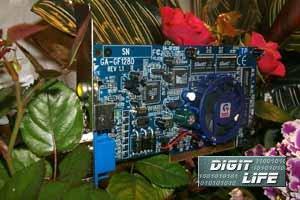 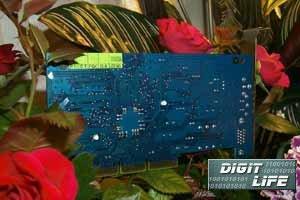 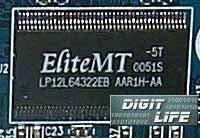 EliteMT produces memory chips with 5 ns access time which corresponds to 200 MHz. But the memory works at 220 MHz. And, as it has already become a tradition, the fastest memory used on the cards are produced by Elite Semiconductor. This memory demonstrates not only the highest technical parameters, but also a greater overclocking potential. The design of the card is similar to the reference one from NVIDIA. The only difference lies in a TV-out. There are 2 TV-out connectors: S-Video and RCA. 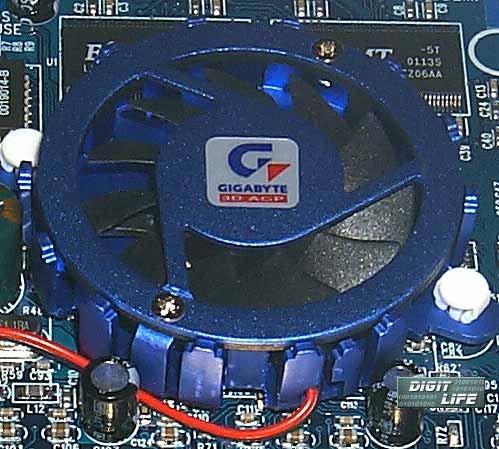 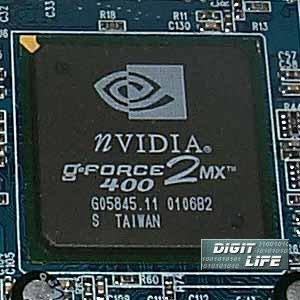 The card is traditionally sky-blue. The color and the form of the cooler installed on the GPU emphasize a peculiar style of this card. The cooling device is rather effective. The only drawback is an aluminum plate glued between a chip and a cooler, which is, though, easy to deinstall. In my opinion, usual thermo paste is much more effective, taking into consideration that the heat sink is mounted on the card with fasteners. As I have already mentioned, the card is equipped with a TV-out, which is identical to cards based on NVIDIA processors (except the connectors). 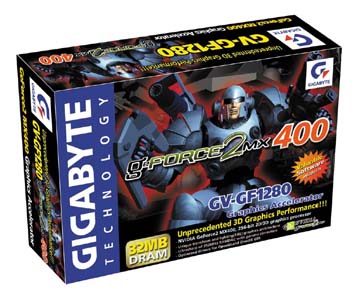 The card ships in a Retail-package (unfortunately, this sample was received in a technological package). I can't say now how the manufacturer is going to distinguish former GV-GF1280-32P cards and new MX400 based ones. Maybe a box will have a special sticker. The box contains:
OverclockingThe Gigabyte GV-GF1280-32P 5ns SDRAM managed to reach 240/245 MHz frequency. Although it is not a record among GeForce2 MX cards, it is still impressing! Of course, such scores were achieved due to the fast memory and a chipset working at higher frequencies than a traditional GeForce2 MX. This might positively tell upon the performance in 3D but we'll see. Installation and driversTest system configuration:
ViewSonic P810 (21") and ViewSonic P817 (21") monitors supplemented the test systems. For testing we used drivers from NVIDIA of 12.40 version, VSync was off. For comparison the results of the following cards are given: SIGMA Cyber6000 (GeForce2 GTS), SIGMA Cyber5500 (GeForce2 MX), SUMA Platinum GeForce2 MX400. Test results2D graphics shows excellent results. I hope that the 2D quality will be also high in case of all Gigabyte cards. Of course, my comments concern a plain user, and not a demanding professional with a 21-inch monitor. Note that the 2D quality may greatly depend not only on a vendor but also on a definite sample. And before accusing your card of poor performance check whether your monitor corresponds to the requirements you set for the video card. Now comes 3D performance. Here we used the following programs:
Quake3 Arenademo002The tests were carried out in two modes: Fast (shows card's work in 16-bit color) and High Quality (shows card's work in 32-bit color). 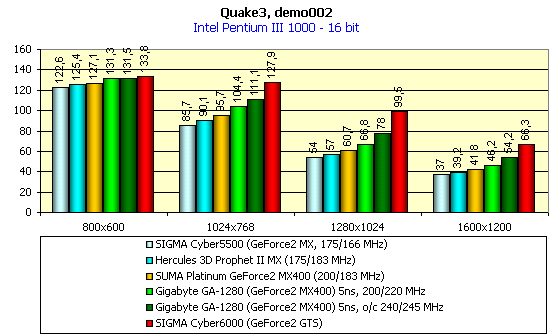 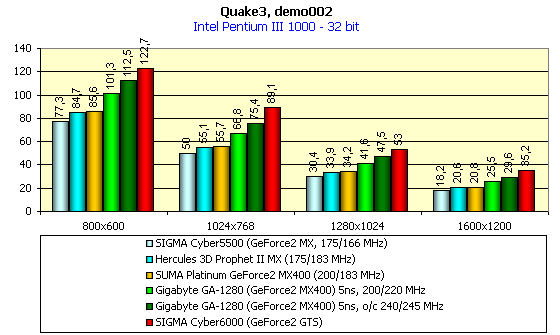 All GeForce2 MX (MX400) cards increase the performance in accordance with the frequency growth. That is why there is nothing extraordinary. The overclocking helped much the Gigabyte GV-GF1280-32P 5ns SDRAM in 32-bit color, the gap between this card and the GeForce2 GTS based one is minimal. GiantsWith this game we will test the scalability, i.e. how the CPU frequency influences the 3D performance. Note that the tests are conducted in the Direct3D. All parameters are set to maximum, that is why the test is very tough and even stressful for many cards. The Hardware T&L is enabled. 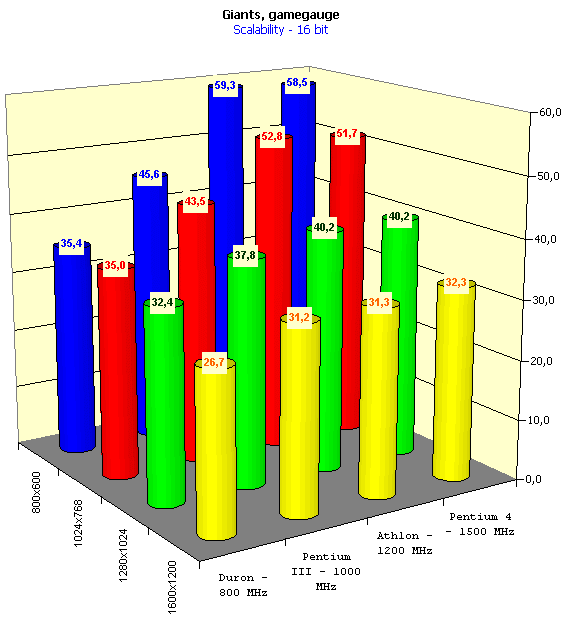 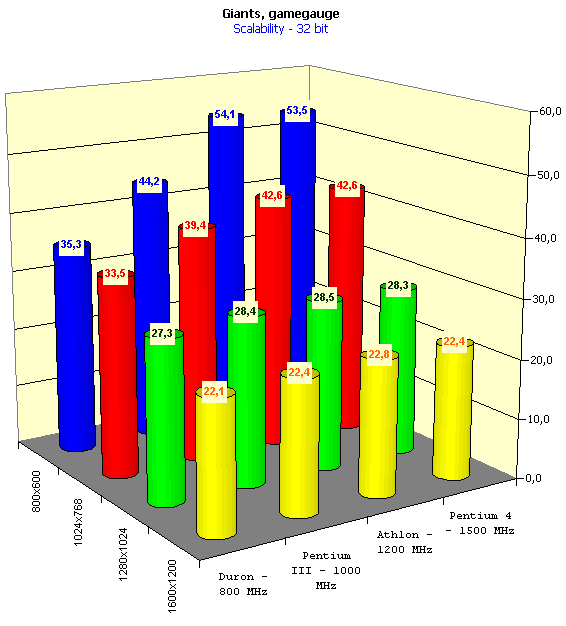 Despite the fact that GeForce2 MX video cards belong to a low-end sector their price has dropped down to the level of the RivaTNT2Pro, RivaTNT2Ultra cards, and it may seem that these cards don't need high-speed processors. But the Giants shows how tremendously the performance may drop even on the Duron 800 MHz, even at the maximum load of the video card! Of course, there are a lot of games which don't depend so severely on a processor, but the results of the tests matter a lot. Even in the 32-bit color, where the speed depends on a video card nearly everywhere, there is some performance gain when taking more powerful processors. At the resolution of 800X600 the performance on the Pentium 4 platform is nearly the same as obtained with the Athlon. ConclusionMany video card manufacturers are trying to draw attention to their products by integrating new solutions. On the one hand, there is only one chip with a couple of specifications, and at first sight all cards must look the same (like in case of the GeForce256 and GeForce2 GTS at the beginning). But exactly this peculiarity of the market allows manufacturers to find new modifications of their products thus increasing the demand for their products. Some solutions have already become traditional. Gigabyte has also followed this way, attracting attention to its products by increasing the frequency due to the fast memory. By the way, the Gigabyte GV-GF1280-32P 5ns SDRAM will be priced not higher than the GV-GF1280-32P cards (which were less than $80 in the middle of May 2001). So, if the company keeps its promises and don't replace the memory with a worse one, the cards will be very popular. Note that so far we haven't received the confirmation that all GeForce2 MX400 based cards will ship with this memory. For more detailed comparison of cards of this and other classes refer to our 3Digest. Highs:
Lows:
Write a comment below. No registration needed!
|
|
Platform · Video · Multimedia · Mobile · Other || About us & Privacy policy · Twitter · Facebook
Copyright © Byrds Research & Publishing, Ltd., 1997–2011. All rights reserved.